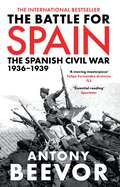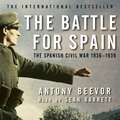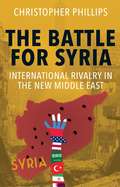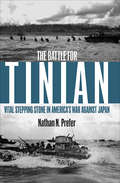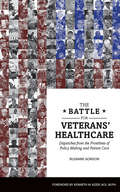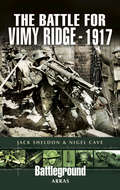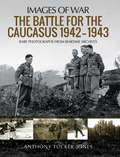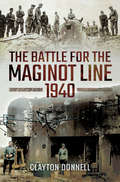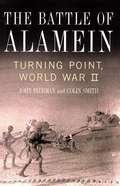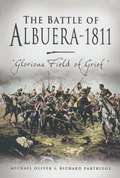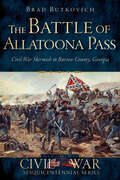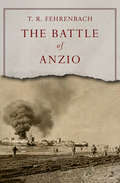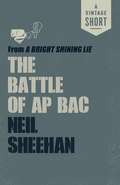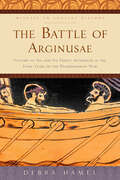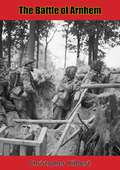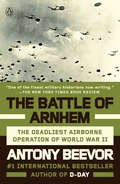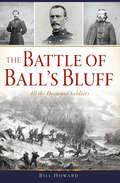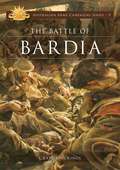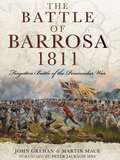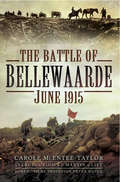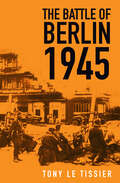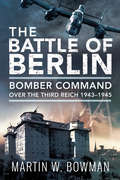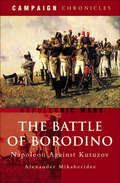- Table View
- List View
The Battle for Spain: The Spanish Civil War 1936-1939
by Antony Beevor'Fascination lies in the human drama, superbly captured by Beevor ... A vivid chronicle of a dreadful time and place' Max Hastings, Sunday Times'A moving masterpiece' TLSThe civil war that tore Spain apart between 1936 and 1939 and attracted liberals and socialists from across the world to support the cause against Franco was one of the most hard-fought and bitterest conflicts of the 20th century: a war of atrocities and political genocide and a military testing ground before WWII for the Russians, Italians and Germans, whose Condor Legion so notoriously destroyed Guernica.Antony Beevor's account narrates the origins of the Civil War and its violent and dramatic course from the coup d'etat in July 1936 through the savage fighting of the next three years which ended in catastrophic defeat for the Republicans in 1939. And he succeeds especially well in unravelling the complex political and regional forces that played such an important part in the origins and history of the war.
The Battle for Spain: The Spanish Civil War 1936-1939
by Antony BeevorThe civil war that tore Spain apart between 1936 and 1939 and attracted liberals and socialists from across the world to support the cause against Franco was one of the most hard-fought and bitterest conflicts of the 20th century: a war of atrocities and political genocide and a military testing ground before WWII for the Russians, Italians and Germans, whose Condor Legion so notoriously destroyed Guernica.Antony Beevor's account narrates the origins of the Civil War and its violent and dramatic course from the coup d'etat in July 1936 through the savage fighting of the next three years which ended in catastrophic defeat for the Republicans in 1939. And he succeeds especially well in unravelling the complex political and regional forces that played such an important part in the origins and history of the war.Read by Sean Barrett(p) 2011 Isis Publishing Ltd
The Battle for Syria: International Rivalry in the New Middle East
by Christopher PhillipsAn unprecedented analysis of the crucial but underexplored roles the United States and other nations have played in shaping Syria’s ongoing civil war Most accounts of Syria’s brutal, long-lasting civil war focus on a domestic contest that began in 2011 and only later drew foreign nations into the escalating violence. Christopher Phillips argues instead that the international dimension was never secondary but that Syria’s war was, from the very start, profoundly influenced by regional factors, particularly the vacuum created by a perceived decline of U.S. power in the Middle East. This precipitated a new regional order in which six external protagonists—the United States, Russia, Iran, Saudi Arabia, Turkey, and Qatar—have violently competed for influence, with Syria a key battleground. Drawing on a plethora of original interviews, Phillips constructs a new narrative of Syria’s war. Without absolving the brutal Bashar al-Assad regime, the author untangles the key external factors which explain the acceleration and endurance of the conflict, including the West’s strategy against ISIS. He concludes with some insights on Syria and the region's future.
The Battle for Syria: International Rivalry in the New Middle East
by Christopher PhillipsAn unprecedented analysis of the crucial but underexplored roles the United States and other nations have played in shaping Syria’s ongoing civil war“One of the best informed and non-partisan accounts of the Syrian tragedy yet published.”—Patrick Cockburn, Independent Syria’s brutal, long-lasting civil war is widely viewed as a domestic contest that began in 2011 and only later drew foreign nations into the fray. But in this book Christopher Phillips shows the crucial roles that were played by the United States, Russia, Iran, Saudi Arabia, Turkey, and Qatar in Syria’s war right from the start. Phillips untangles the international influences on the tragic conflict and illuminates the West’s strategy against ISIS, the decline of U.S. power in the region, and much more. Originally published in 2016, the book has been updated with two new chapters.  
The Battle for Tinian: Vital Stepping Stone in America's War Against Japan
by Nathan N. PreferThis vivid history chronicles the decisive US naval campaign that secured the Japanese island of Tinian—the site that would launch the end of WWII. In July 1944, the United States Navy and Marine Corps, Army, and Air Corps descended on the Pacific island of Saipan, just three miles away from the Japanese stronghold on the island of Tinian. There had been 20,000 Japanese troops on Saipan before the US unleashed a horrific all-arms campaign. The sudden silence indicated it was now Tinian&’s turn. When the battle for Tinian finally took place, the US acted with great skill. Historian Samuel Elliot Morrison called it &“the most perfectly executed amphibious operation of the entire war.&” Nevertheless, the Japanese shore batteries riddled the battleship Colorado, killing scores, and made multiple hits on a destroyer, killing its captain. On the island itself, the United States used napalm for the first time, paving the way for Marines rooting out strongpoints. One last banzai attack signaled the end to enemy resistance, as Marines fought toe-to-toe with their antagonists in the dark. After Tinian was secured, the United States built the biggest airport in the world there—home to hundreds of B-29 Superfortresses. Among these, just over a year later, were the Enola Gay and Bockscar, which, with their atomic bombs, would quickly bring the Japanese conflict, and the Second World War, to an end.
The Battle for Veterans’ Healthcare: Dispatches from the Front Lines of Policy Making and Patient Care
by Suzanne GordonIn The Battle for Veterans' Healthcare, award-winning author Suzanne Gordon takes us to the front lines of federal policymaking and healthcare delivery, as it affects eight million Americans whose military service makes them eligible for Veterans Health Administration (VHA) coverage.Gordon’s collected dispatches provide insight and information too often missing from mainstream media reporting on the VHA and from Capitol Hill debates about its future. Drawing on interviews with veterans and their families, VHA staff and administrators, health care policy experts and Congressional decision makers, Gordon describes a federal agency under siege that nevertheless accomplishes its difficult mission of serving men and women injured, in myriad ways, while on active duty.The Battle for Veterans’ Healthcare is an essential primer on VHA care and a call to action by veterans, their advocacy organizations, and political allies. Without lobbying efforts and broader public understanding of what’s at stake, a system now functioning far better than most private hospital systems may end up looking more like them, to the detriment of patients and providers alike.
The Battle for Vimy Ridge, 1917 (Battleground Arras Ser.)
by Nigel Cave Jack SheldonIn a new departure in the Battleground Europe series, this book is a guide to both sides of a major battle in this case to the Canadian Corps operations against 1st Bavarian Reserve Corps at Vimy from 9 12 April 1917, which formed part of the opening of the British offensive, known as the Battle of Arras. Historically, the capture of Vimy Ridge was an event far more significant than its undoubted military importance alone. Here for the first time all four divisions of the Canadian Corps were deployed in line together in one offensive; and although the Corps went to fight even greater battles, Vimy marked a key point in the emergence of Canada as a fully sovereign nation.Although the Canadian side of the story has been well chronicled by a number of writers, until now there has been little concerning the defense during this great battle. Now, the accounts of the German soldiers and their commanders are combined with those of the Canadians and British deployed on the other side of No Mans Land and not simply those who fought above ground, but tunnelers also.
The Battle for the Caucasus, 1942–1943: Rare Photogaphs from Wartime Archives (Images of War)
by Anthony Tucker-JonesIn late 1942 Hitler's forces advanced far into the Caucasus in the southern Soviet Union in one of the most ambitious offensives of the Second World War, but this extraordinary episode is often forgotten-it is overshadowed by the disastrous German attack on Stalingrad which took place at the same time. Using over 150 wartime photographs Anthony Tucker-Jones gives the reader a graphic, concise introduction to this remarkable but neglected campaign on the Eastern Front.Operation Edelweiss was designed to seize the oil fields of Maikop, Baku and Grozny. Seen by some as a wholly unnecessary diversion of resources from the critical confrontation at Stalingrad, the assault on the Caucasus aimed to secure oil supplies for the Germans and deny them to the Soviets.As this memorable selection of photographs shows, the Werhmacht came close to success. Their forces advanced almost as far as Grozny, famously raising the Nazi flag over Mount Elbrus, the highest peak in the region, before they were compelled into a hurried withdrawal by the rapid deterioration of the German position elsewhere on the Eastern Front.
The Battle for the Maginot Line, 1940
by Clayton DonnellWhat was it like as a French soldier to defend the Maginot Line when the Germans invaded in 1940, and was the line really a strategic and tactical disaster a massive waste of resources? Clayton Donnell's expert, finely detailed and graphic account of the role of the Maginot Line in the defense of France gives the reader an inside view of life in the bunkers, casemates and forts the sights, the sounds and the terror of the German attacks. And it questions common assumptions about the effectiveness of the resistance offered by the defenders and the impact the line had on the German assault. The layout of the line from Dunkirk to Switzerland, along the Alpine passes to the Riviera, and on the island of Corsica is described in expert detail, as is its history, construction and development. But the narrative concentrates on its performance in combat and the experience of the soldiers who manned it as the German offensive broke over them.
The Battle of Alamein: Turning Point, World War II
by John Bierman Colin SmithA new perspective on the important battle of Alamein drawing on hitherto unpublished material
The Battle of Albuera 1811: Glorious Fields of Grief
by Michael Oliver Richard PartridgeOn 16 May 1811 a combined British, Portuguese and Spanish force commanded by the British general Beresford met the French army under Soult at Albuera in southern Spain. What followed was one of the bloodiest and most controversial battles of the Peninsular War. Yet despite the battle's significance in the wider campaign to expel Napoleon's armies from Spain, the story of Albuera has rarely received the coverage accorded to other battles of the war. In this ground-breaking book, Michael Oliver and Richard Partridge seek to set the historical record straight. They examine the carnage of Albuera in unprecedented detail, and they give a lucid account of the circumstances and the conflicting allied and French strategies that gave rise to this awful confrontation. They also offer vivid portraits of the personalities and military skills of the notable commanders who took part.
The Battle of Allatoona Pass: Civil War Skirmish in Bartow County, Georgia (Civil War Ser.)
by Brad ButkovichA Civil War historian explores one of the conflict&’s most dramatic and significant yet overlooked battles. In the 1840s, engineers blasted through 175 feet of earth and bedrock at Allatoona Pass, Georgia, to allow passage of the Western & Atlantic Railroad. Little more than twenty years later, both the Union and Confederate armies fortified the hills and ridges surrounding the gorge to deny the other passage during the Civil War. In October 1864, the two sides met in a fierce struggle to control the iron lifeline between the North and the recently captured city of Atlanta. Though small compared to other battles of the war, this division-sized fight produced casualty rates on par with or surpassing some of the most famous clashes. In this expertly researched volume, Brad Butkovich explores the controversy, innovative weapons and unwavering bravery that make the Battle of Allatoona Pass one of the war's most unique and savage battles.
The Battle of Anzio
by T. R. FehrenbachA major turning point of WWII: The incredible true story of Allied forces who held a strip of Italian beach against Nazi bombardment. The Battle of Anzio was among the most bloody of the World War II conflicts. T. R. Fehrenbach&’s accurate account stunningly depicts the reality of the Allied forces&’ fight for survival on an Italian beach as they stormed what Winston Churchill called the soft underbelly of the Axis powers. In one of the turning points of the war, the allies clung to a narrow strip of sand while German planes swooped in from above and artillery shells and mortar fire pounded them on the ground. This is a true and dramatic account of the battle from the perspective of a soldier and military historian, told with pride, compassion, and spirit. T. R. Fehrenbach&’s account of war needs no embellishing and brings you into the thick of the action.
The Battle of Ap Bac
by Neil SheehanAn eBook short.In the opening years of the Vietnam War, a small group of American military advisors and their South Vietnamese allies were facing down the Viet Cong. The confident Americans were there to do what seemed elementary: help the South Vietnamese army defeat a ragtag guerrilla enemy. They were assured of swift success. But one officer, John Paul Vann, saw darker omens for the future--and in the Battle of Ap Bac, the Viet Cong proved him correct.Encapsulating the great terrors, mistakes, ironies, and courageous acts of the Vietnam War, "The Battle of Ap Bac" recounts the clash in which the Viet Cong first won their spurs. It is an exciting, terrifying, fast-paced portrait of close-contact warfare in the rice paddies, the story of John Vann's attempt to singlehandedly change the terms of battle and avoid the relentless killing grounds of Vietnam that lay ahead. A key selection from Neil Sheehan's masterpiece, A Bright Shining Lie--which remains the preeminent history of the Vietnam War--it offers a prescient warning for current conflicts between powerful forces and underestimated foes.
The Battle of Arginusae: Victory at Sea and Its Tragic Aftermath in the Final Years of the Peloponnesian War (Witness to Ancient History)
by Debra HamelA harrowing, immersive introduction to a violent turning point in the conflict between Sparta and Athens.A pivotal skirmish involving nearly three hundred Athenian and Spartan ships toward the end of the Peloponnesian War, the Battle of Arginusae was at the time the largest naval battle ever fought between warring Greeks. It was a crucial win for the Athenians, since losing the battle would have led to their total defeat by Sparta and, perhaps, the slaughter and enslavement of their entire population. Paradoxically, the win at Arginusae resulted in one of the worst disasters to befall the Athenians during the brutal twenty-seven-year war.Due to a combination of factors—incompetent leadership, the weariness of the sailors, a sudden storm—the commanders on the scene failed to rescue the crews of twenty-five Athenian ships that had been disabled during the battle. Thousands of men, many of them injured, were left clinging to the wreckage of their ships awaiting help that never came. When the Athenians back home heard what had happened, they deposed the eight generals who had been in command during the battle. Two of these leaders went into exile; the six who returned to Athens were tried and eventually executed.The Battle of Arginusae describes the violent battle and its horrible aftermath. Debra Hamel introduces readers to Athens and Sparta, the two thriving superpowers of the fifth century B.C. She provides a summary of the events that caused the long war and discusses the tactical intricacies of Greek naval warfare. Recreating the claustrophobic, unhygienic conditions in which the ships' crews operated, Hamel unfolds the process that turned this naval victory into one of the most infamous chapters in the city-state's history. Aimed at classics students and general readers, the book also provides an in-depth examination of the fraught relationship between Athens' military commanders and its vaunted sovereign democracy.
The Battle of Arnhem
by Christopher HibbertIn this book, first published in Christopher Hibbert, one of Britain’s foremost historians, tells the true story of the Battle of Arnhem which was fought in September 1944 on Dutch soil and made famous in the 1977 film A Bridge Too Far.Nine thousand men of the First British Airborne Division were parachuted into the peaceful countryside that surrounded Arnhem. Their objective was to capture and hold the bridge over the Rhine ahead of the advancing British Second Army. Nine days later, after some of the fiercest street-fighting of the war, 2,000 paratroopers managed to escape to safety. This is the vivid account of how a brilliant plan turned into an epic tragedy.‘Alive with the detail that evokes the smoking background’—Daily Telegraph‘Finely recorded...truly the battle of Arnhem has been fortunate in its historian’—Sunday Times‘Clear-sighted, well written and scrupulously fair…it deserves to stand with the best of the battle chronicles’—Sunday Telegraph
The Battle of Arnhem: The Deadliest Airborne Operation of World War II
by Antony BeevorThe prizewinning historian and internationally bestselling author of D-Day reconstructs the devastating airborne battle of Arnhem in this gripping new account.On September 17, 1944, General Kurt Student, the founder of Nazi Germany's parachute forces, heard the groaning roar of airplane engines. He went out onto his balcony above the flat landscape of southern Holland to watch the air armada of Dakotas and gliders, carrying the legendary American 101st and 82nd Airborne Divisions and the British 1st Airborne Division. Operation Market Garden, the plan to end the war by capturing the bridges leading to the Lower Rhine and beyond, was a bold concept, but could it have ever worked? The cost of failure was horrendous, above all for the Dutch who risked everything to help. German reprisals were pitiless and cruel, and lasted until the end of the war. Antony Beevor, using often overlooked sources from Dutch, American, British, Polish, and German archives, has reconstructed the terrible reality of the fighting, which General Student called "The Last German Victory." Yet The Battle of Arnhem, written with Beevor's inimitable style and gripping narrative, is about much more than a single dramatic battle--it looks into the very heart of war.
The Battle of Ball's Bluff: All the Drowned Soldiers (Civil War Series)
by Bill HowardThree months after the Civil War's first important battle at Manassas in 1861, Union and Confederate armies met again near the sleepy town of Leesburg. What began as a simple scouting mission evolved into a full-scale battle when a regiment of Union soldiers unexpectedly encountered a detachment of Confederate cavalry. The Confederates pushed forward and scattered the Union line. Soldiers drowned trying to escape back to Union lines on the other side of the Potomac River. A congressional investigation of the battle had long-lasting effects on the war's political and military administration. Bill Howard narrates the history of the battle as well as its thorny aftermath.
The Battle of Bardia (Australian Army Campaigns #9)
by Craig StockingsOn the morning of 3 January 1941, Australians of the 6th Division led an assault against the Italian colonial fortress village of Bardia in Libya, not far from the Egyptian-Libyan frontier. The ensuing battle was the second of the First Libyan Campaign, but the first battle of the Second World War planned and fought predominantly by Australians. The fortress fell to the attackers a little over two days after the attack began, in what could only be described as a remarkable victory. At a cost of 130 killed and 326 wounded, the 6th Division captured around 40,000 Italian prisoners and very large quantities of military stores and equipment. The victory was heralded at the time in Australia as one of the greatest military achievements of that nation's military history. Quite soon afterwards, however, overshadowed perhaps by Rommel's subsequent desert advances, the tragedy in Greece, and the war in the Pacific, Bardia slipped from the public mind. Very few Australians today have heard of the battle. This book attempts to bring Bardia back into the light.
The Battle of Barrosa: Forgotten Battle of the Peninsular War
by Martin Mace John GrehanBy the winter of 1810-11, the armies of Napoleon had overrun most of Spain and Joseph Bonaparte sat on the throne in Madrid. But the Spanish Government had found refuge in the fortress-port of Cadiz and the Spaniards refused to admit that they had been conquered. With a British army under Sir Thomas Graham helping to defend Cadiz, the Spanish cause seemed certain to prevail.But then the Spaniards wanted to throw Graham's force into a reckless battle against the French. If the battle was won, the siege of Cadiz would be lifted; if the battle was lost Cadiz would be rendered defenseless and the Spanish government left at the mercy of the invaders.The opposing forces met on the heights of Barossa in one of the most savage encounters of the Peninsular War. At stake was the very survival of the Spanish nation and the future course of the war against Napoleon.The Battle of Barossa is the first book to examine this crucial campaign in detail and to reveal its true historical importance.
The Battle of Bellewaarde, June 1915
by Carole McEntee-TaylorIt was 2am on the 16th June 1915 and dawn was slowly breaking over Bellewaarde. It was exceptionally quiet, the troops of 3rd Division were situated on the western edge of Railway Wood and shrouded in a thick mist which reduced visibility and gave the illusion of safety. Across the few yards of no man's land, the German troops of Reserve Infantry Regiments (RIR) 248 and 246, and Unter-Elsssisches Infanterie-Regiment Nr. 132 were also blanketed in the thick damp mist. It swirled round their trenches, deadening sound and reinforcing the illusion that all was secure. Fifty minutes later the planned British artillery bombardment began. By the end of the day more than 4,000 men would be casualties on a field approximately half a mile square. At the close of the 2nd Battles of Ypres, the German trenches between the Menin Road and the Ypres-Roulers railway formed a salient. From Bellewaarde ridge, situated on the eastern side of the lake, they were able to overlook the greater part of the ground east of Ypres. In early June it was decided to attack the salient, and take possession of Bellewaarde ridge. The attack was to be carried out by the 9th Brigade of the 3rd Division, with 7th Brigade in support.The book is a tribute to those who fought and died at Bellewaarde on the 16th June 1915 and author royalties will be donated to a fund to help raise money for a memorial.
The Battle of Berlin 1945
by Tony Tissier‘Tony Le Tissier is arguably the finest English-language historian of the Battle of Berlin’ defenceWebThe Battle of Berlin was a battle on an unprecedented scale. The Soviets massed 1.6 million troops forOperation Berlin, and Marshal Zhukov in the centre had half of them, but his initial attack floundered, lasting four days instead of one. It was so costly that he had to revise his plans for taking the city, and to revise them yet again when Stalin allowed his rival, Marshal Koniev, to intervene. The battle thus became a contest for the prize of the Reichstag. Meanwhile, Hitler and his courtiers sought to continue the struggle in the totally unrealistic atmosphere that prevailed in his bunker, while soldiers and civilians alike suffered and perished unheeded all around them.In The Battle of Berlin 1945, Tony Le Tissier brings us the definitive history of the last great battle of the Second World War – a fight to the death in the smouldering ruins of the capital of Hitler’s Third Reich.
The Battle of Berlin: Bomber Command Over the Third Reich, 1943–1945
by Martin W. Bowman&“A fascinating look into the aircrews used and the effect on those who had to live through this constant bombing&” by the RAF during World War II (UK Historian). Berlin was bombed by four Allied air forces between 1940 and 1945. British bombers alone dropped 45,517 tons of bombs, while the Americans a further 23,000 tons. By 1944, some 1.2 million people, 790,000 of them women and children, about a quarter of Berlin&’s population, had been evacuated to rural areas. An effort was made to evacuate all children from Berlin, but this was defeated by parents and many evacuees who soon made their way back to the city. However, by May 1945, 1.7 million people—40% of the population—had fled the city. This fitting tribute to those who died in the relentless struggle to knock Berlin, and hopefully Germany, out of the war resonates with eyewitness accounts and background information which the author has painstakingly investigated and researched. The result is a hugely fascinating and highly readable narrative containing very real and unique observations by British and Commonwealth aircrew and, equally importantly, the long-suffering citizens of Berlin, and well as the capital&’s defenders. Though not a defeat in absolute terms, in the operational sense The Battle of Berlin was an offensive that Air Marshal Sir Arthur Harris and his aircrews could not win. &“Berlin won&” concluded Sir Ralph Cochrane, the Air Officer Commanding 5 Group RAF Bomber Command. &“It was just too tough a nut.&”&“An impressively informative, deftly written, exceptionally well documented, and expertly organized history . . . a seminal work of original scholarship.&” —Midwest Book Review
The Battle of Betazed: Star Trek The Next Generation (Star Trek: The Next Generation)
by Charlotte Douglas Susan KearneyCounselor Deanna Troi and the crew of the USS Enterprise work to carry out a perilous and desperate plan to stop the invasion of her home planet of Betazed by the Dominion conquerors.In the darkest hours of the Dominion War, as the Federation&’s downfall seemed ever more certain, Jem&’Hadar and Cardassian forces conquered Betazed, the homeworld of Deanna Troi. Their victory sent shock waves through the Alpha Quadrant, and put the Dominion within striking distance of Vulcan, Andor, Tellar, and possibly Earth itself. To secure their position in the very heart of the Federation, the Cardassians begin constructing space station Sentok Nor in orbit of Betazed. The station is to serve as both the seat of the Dominion occupation and the site of horrific experiments by Cardassia&’s foremost exobiologist, the infamous Dr. Crell Moset. With Starfleet&’s forces spread too thickly in the ongoing struggle to retake Betazed outright, the USS Enterprise along with some old and new friends, is deployed to carry out a dangerous and desperate plan. But no matter what the outcome, the consequences could alter Betazed irrevocably, forcing Deanna Troi to choose between her world&’s survival and its very soul.
The Battle of Borodino: Napoleon Against Kutuzov (Campaign Chronicles)
by Alexander MikaberidzeAlbert Balls individuality and his insistence on fighting alone set him apart from other fighter pilots during World War One. His invincible courage and utter determination made him a legend not only in Britain but also amongst his enemies, to whom the sight of his lone Nieuport Scout brought fear. In 1914 he enlisted in the British army with the 2/7th Battalion (Robin Hoods), of the Sherwood Foresters, Notts and Derby Regiment. By the October of 1914 he had reached the rank of Sergeant and then in the same month was made a Second-Lieutenant to his own battalion. In June 1915 he paid for private tuition and trained as a pilot at Hendon. In October 1915 he obtained Royal Aero Club Certificate and requested transfer to the Royal Flying Corps. The transfer granted, he further trained at Norwich and Upavon, being awarded the pilot's brevet on 22 January 1916. On 16 May 1916—flying Bristol Scout 5512—he opened his score, shooting down an Albatros C-type over Beaumont. On 29 May 1916 he shot down two LVG C-types, whilst flying his Nieuport 5173.Captain Albert Ball made his final flight on 7 May 1917 when he flew SE5 A4850 as part of an eleven-strong hunting patrol into action against Jagdstaffel 11, led by Lothar Von Richthofen. It was a very cloudy day. Albert was pursuing Lothar's Albatros Scout who crash-landed, wounded. Then Albert was seen by many observers to dive out of a cloud and crash. He died minutes later in the arms of a French girl, Madame Cecille Deloffre. He rose from obscurity to the top rank of contemporary fighter pilots in only 15 months. In that period he had been awarded the MC, DSO and two Bars and was credited with at least 44 victories. He was posthumously awarded the Victoria Cross.
